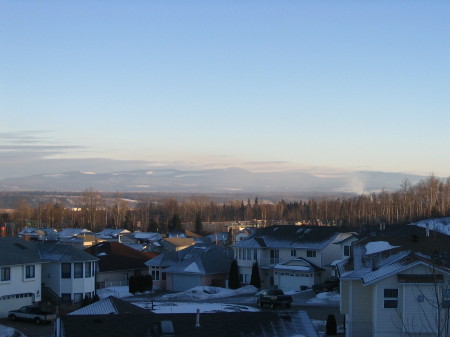Level of 'Finer' Particulates Builds Up in Airshed

Poor Air hangs over the city to the southeast of Starlane Subdivision
Without any snow or rain to dampen the road dust, the level of fine particulate matter being trapped in the airshed above Prince George remains high, but it’s the level of finer particulates, associated with combustion sources, that continues to climb.
The Ministry of Environment’s Air Quality objective for PM10 is 50 μg/m3 for a 24-hour average.
Twenty-four hour levels were 52 at Downtown, 42 at College Heights and 56 at the BCR site Friday afternoon. That’s similar to the readings recorded on Thursday, with an improvement at the BCR site.
But the monitoring station in the Downtown is now recording a 24-hour level of 27 for PM2.5, the finer particulates, up from 19 on Thursday afternoon.
It’s those finer particulates, from the incomplete combustion of wood, that are breathed even deeper into lungs.
Speaking with Opinion250 earlier this week, Medical Health Officer Dr. Lorna Medd, says Prince George’s population is too small to show a direct correlation between Air Quality Advisories and visits to the emergency ward at PGRH, which, she says, is unfortunate because people tend to resonate much more strongly when they can see a link right in their community. But Dr. Medd says larger studies have shown the direct cause-effect of poor air. (click here for earlier story)
The Ministry’s Environmental Protection Branch has an abstract of a report prepared by UBC Dr. Sverre Vedal on the health effects of inhalable particles and its implications for B.C.. To view the abstract, click here:
http://www.env.gov.bc.ca/air/particulates/heoipifb.html#conclusions
Previous Story - Next Story
Return to Home










I think it is unfortunate that Dr. Medd should choose to use these kind of words. She knows full well, and now the readers who went to the linked site do as well, that there is ample evidence not only in BC but in other larger health regions in the world who do such epidemiological studies that there is a correlation. In fact, in the linked document it also states that the PM10 situation is worse in the smaller communities in the Interior of the province than in the GVRD.
So, whether it is shown in PG or not really does not matter. The epidemilogical studies have broad application and it would be more a case of someone having to show that PG does not fit the norm.
We do not need these types of what are essentially misinformation from our public officials, no matter what ministry they are with.
Again, I repeat myelf, no wonder we are seen to be functionally illiterate when it comes to reading "newspapers" when we get fed spin after spin after spin.